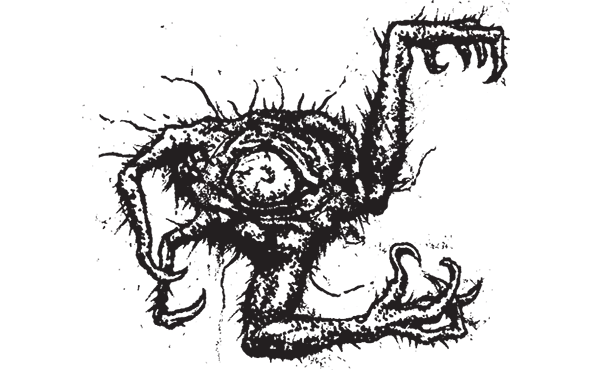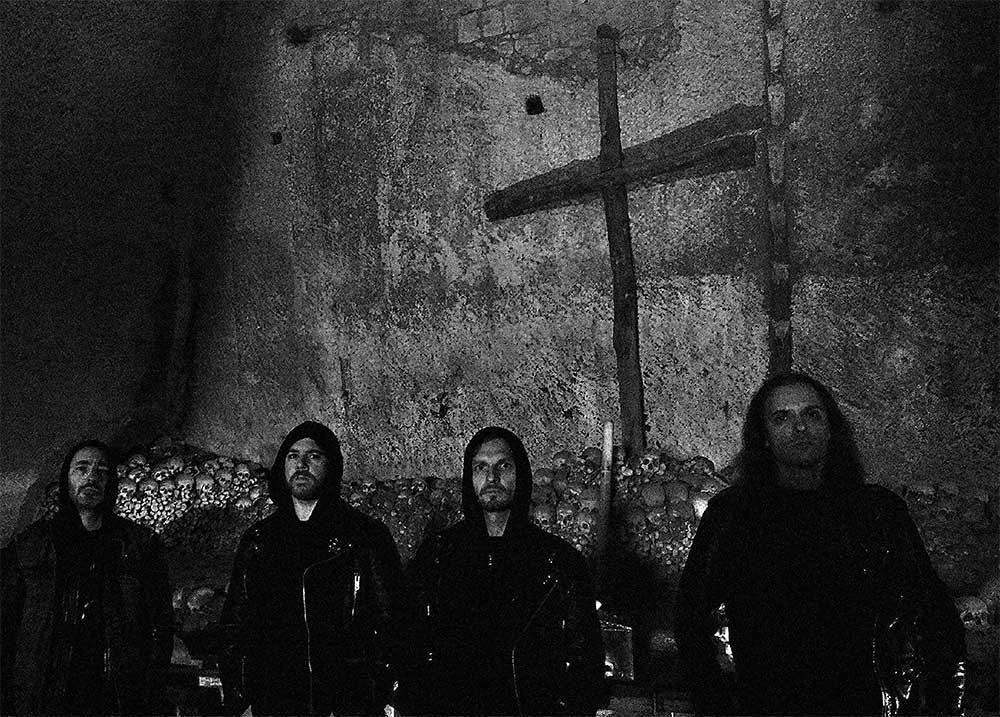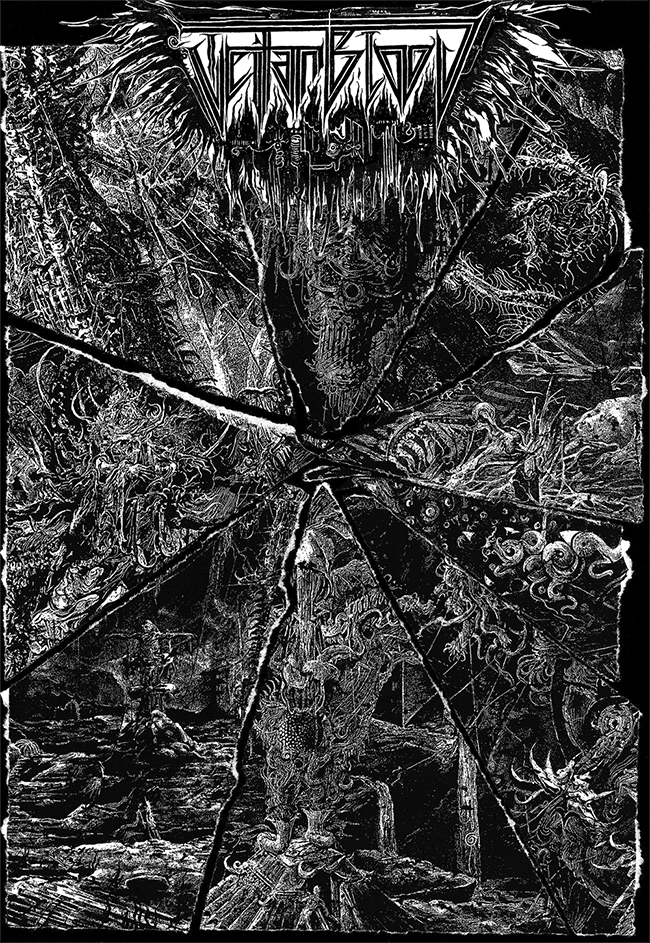Teitanblood
2021-01-20
by Niklas Göransson
Unearthly fiends reciting human words, Teitanblood have reopened their vortex of sonic vibrations. Guitarist and vocalist NSK speaks of breaking bones and crossing thresholds.
The following is an excerpt from the full article, which is twice as long and published in Bardo Methodology #6. The same issue also includes conversations with FUNERAL MIST, DEAD CAN DANCE, DEATHSPELL OMEGA, SUNN O))), MYSTICUM, ADORIOR, Metalion, Dave Haley, OFDRYKKJA, Michael Denner, NECROS CHRISTOS, and Wim Hof.

– “The Baneful Choir” offers fifty minutes of our filthy and soul-churning interpretation of black and death metal, paired with demented visuals from beyond. I’m constantly developing and designing ideas from different musical and conceptual sources, and perhaps part of upholding that methodology takes an expression through my approach to music – always keeping in mind a large-scale vision of the atmosphere I’m hoping to convey… be it the abrasive occult filth of “Seven Chalices”, the impenitent relentless insanity of “Death”, or the nightmarish mechanical oppression of “The Baneful Choir”.
The third TEITANBLOOD record, which was released by Norma Evangelium Diaboli in October 2019, comes five years after its predecessor, “Death”.
– J lived abroad for several years, so rehearsals were only possible whenever he was able to visit Spain and work with me on the material. It was decided to leave a lot more open to improvisation this time around, so once we had the first few songs finished, along with ideas for several more, we entered Moontower Studios in Barcelona. After working on a few arrangements together with our long-time producer, Javi Félez, we ended up recruiting him as permanent guitar player for TEITANBLOOD. The remaining rehearsals and recordings took place over regular visits to Moontower, with plenty of interaction and spontaneity among us but still under the ever-watchful eye of my insanely obsessive character. This creative process differed drastically from our previous records, in that I used to prepare all music and concepts beforehand and rehearsals ran with regularity. Further differences reside in the visuals, which, as confirmed by this album, are a crucial element in everything we do. Previously, artwork ideas have always been shared and discussed with Timo well in advance, but this was not the case here.
Timo Ketola is a Finnish artist and the former editor of cult underground ‘zine Dauthus. In our conversation from Bardo Methodology #1, NSK mentioned that much of the inspiration for their 2009 debut, “Seven Chalices”, was drawn from Dauthus #3; ever since, Ketola has been aesthetically involved in everything TEITANBLOOD has released.
– I still have Timo’s hand-written letter where he’s going fucking mental and requesting to become personally involved after I sent him rehearsal recordings from our preparations leading up to “Seven Chalices”. And now, ten years later, the results speak for themselves. However, this time we were already finishing up the recording when my conversations with Timo began. I felt quite conflicted by the fact that this album demanded a heavy visual treatment, which he wouldn’t be able to commit to. Consequently, we decided it was about time to enlarge our circle with someone who could not only deliver art but also become fully involved in the release, which is how I like to work. So, Ketola executed the new cover artwork, but – in order to realise our full ambition in terms of aesthetics – we’ve now welcomed into the fold Alejandro Tedín and Dávid Glomba, two artists whose contributions have been instrumental not only in achieving but actually surpassing our initial vision. Dávid created all the booklet art; after a few emails and exchanges of ideas and drafts, I travelled to Prague to meet him in person. After many hours of discussion over Czech beer, whilst among human bones, we agreed on the entire visual concept of the inlay and booklet, which he then delivered.
That he most certainly did, the LP design really is something else; a frantic Cthulhian psychosis woven together through an insane attention to detail. Whilst Glomba contributed illustrations, the layout was handled by Spanish artist Alejandro Tedín. NSK previously mentioned that Javi Félez not only provided his facilities and production expertise but also joined the band as a full member – as did C.G. Santos, who’s been responsible for the atmospheric ambient interludes ever since “Seven Chalices”.
– Javi comes from an extensive musical background and has dropped ideas and introduced new elements of musicianship which enhanced every aspect of our material. In the case of C.G. Santos, he’d finished ninety percent of his contributions once the album was in its recording stage – with the additional handicap of having to delve into synthesiser theory and practice from scratch, learning by trial and error. C.G. not only experimented with keyboards but also read books about synthesis and programming. As a science person, he’s fascinated by physics and is an extreme fanatic when it comes to learning and dedicating himself to something. Despite the geographical distance, and to help set the right mood for his atmospheres, him and I had ridiculously lengthy conversations about many inspiring records, movies, and images.

Listening to the end result of all this creative conspiring, one notices that TEITANBLOOD have kept tweaking their blueprint without losing touch with the band’s foundations. I have no idea what they’re called but was delighted to discover that those heavy-as-fuck string-bending guitar manoeuvres, as perfected in pieces like “Sleeping Throats of the Antichrist”, have remained part of the repertoire.
– I think we’ve ended up with a very interesting formula combining my modest skills – and the simplified, ever-tributing, and straightforward riffing it results in – with the highly accomplished and merciless drumming style of J, torrents of vocals and effects in multiple layers, as well as a visual approach synched to the music. To my pleasant surprise, a lot of people want to experience that overarching connection and truly enjoy delving into every minor detail lurking beneath the surface. By no means do I intend to compare myself to such a master, but I came across an interview with John Carpenter where he described how Lalo Schifrin, the same guy who wrote the main theme for Mission: Impossible, ripped off LED ZEPPELIN when composing his famous Dirty Harry soundtrack. Carpenter then simplified it further and, of course, used synthesisers instead of guitars.
Lalo Schifrin’s Dirty Harry score, written in ’71, was clearly influenced by LED ZEPPELIN’s 1970 hit “Immigrant Song” – he used a simplified version of its main melody in a sort of jazz-funk arrangement. John Carpenter, in turn, took the basic notes of the Dirty Harry theme and built around them his ground-breaking and widely influential 1976 minimalist electronica soundtrack for Assault on Precinct 13.
– This completely blew my mind because I could totally relate; my ideas for writing riffs are based on the exact same process. Anyway, looking back at our past works – all of them certainly differ from each other but I’m really glad people can still perceive an underlying identity in what we do. In fact, there doesn’t seem to be any form of general consensus when it comes to singling out favourite releases of ours, and that’s great.
Definitely true – as part of my pre-interview research, I read a number of online discussions about TEITANBLOOD and noted several posters claiming to find their 2004 demo to be better than any of the following releases. I’m curious if NSK can relate to assertions of the “Genocide Chants to Apolokian Dawn” tape being superior to an album such as “Death”.
– I’m totally proud of what we did back then but, these days, I’m indifferent to the material. But to each their own and, like I said, I’m glad there’s some variety in our audience’s perceptions. Subjectively, I can kind of understand how the demo might have more meaning than our later material because, at the time it came out, the sound and visuals were very raw and obscure and that was far from the general tendency of those days. The intensity and hype around our demo had more to do with whatever conditions and environments surrounded the release rather than any objective evaluation of the music itself, and I find that extremely compelling.

This brand of oppressively foul and otherworldly death metal was indeed rare in the early 2000s. Another pioneering act in this field was NECROS CHRISTOS, with whom TEITANBLOOD share a long history – having released a split EP together in 2005. The Spanish-German alliance lasts to this day, as evidenced on “The Baneful Choir” which features guest vocals courtesy of the band’s creative force, Malte Gericke.
– What I can say about Malte is that he’s definitely a close brother, an incredible and brutally honest musician who’s well and truly devoted to his occult studies – as a humble scholar, mind you, not for the sake of showing off on social media by projecting an obscure personality – as well as one of the kindest characters with the greatest sense of humour. I always perceive his music, including the RA AL DEE EXPERIENCE, as pure alchemy performed by a magician.
How did the two of you meet?
– In early 2004, shortly after our demo came out, I got the “Black Mass Desecration” tape from Ronald of Horrible Eyes and became a total fanatic of its mesmerising, hypnotic, and sinister atmosphere – the down-tuned riffs and abyssal vocals. For context, it’s important to reiterate how there were very few bands doing this style back then and I’d say NECROS CHRISTOS was the true spearhead. A couple of months later, by pure chance, I met Malte in Germany, followed by intense correspondence. We’ve shared a lot of inspiration and ideas throughout the years, I used to visit him in Berlin and often attended festivals NECROS were playing. I also recall a great night at their rehearsal place, celebrating the release of “Triune Impurity Rites” with the guys from KATHARSIS… or simply walking around the cemetery in front of Malte’s old apartment. Then, of course, the NECROS gig in Athens; headbanging in the first row with Ketola and Telemachos of DEAD CONGREGATION, completely possessed and drowned in spirits.
Greek death metal quartet DEAD CONGREGATION is another act who, around the same time, made a name for themselves with this dark and obscure death metal. In 2009, the band’s guitarist and vocalist, Anastasis Valtsanis, released through his Nuclear Winter label TEITANBLOOD’s “Black Putrescence of Evil” compilation, which contains their entire discography up until that point. Before Anastasis offered to give it an official release, NSK would burn CDRs and photocopy covers to whoever inquired about the material.
– Of course, I was more than happy to burn CDRs and include flyers, photocopies, or any materials I had lying around for anyone with a genuine interest in TEITANBLOOD. We were supposedly unapproachable and difficult to reach because we didn’t join the social media burst back then – which, in turn, somehow influenced our ’status’, whatever that’s supposed to mean – but we’ve always had a website and an email address people can reach us through. These days though, I’m quite horrible with correspondence due to a lack of spare time.
Bearing in mind TEITANBLOOD’s characteristic fusion of unhinged barbarity with intricate and multi-layered arrangements, I’m wondering about their composition process. Using the aforementioned part of “Sleeping Throats of the Antichrist” as an example, that harrowing reverberation monstrosity towards the end – was it conceived through trial and error whilst in the studio, or did they know beforehand they’d be able to produce such noise? It’s hard for me to comprehend how one guitarist and a drummer could replicate something like that in the rehearsal room.
– When our rehearsals in preparation for “Death” began, we were fucking possessed. In fact, “Sleeping Throats…” was perhaps my favourite song ever to play in the rehearsal room, since we could spend longer time with the guitar feedback in the part you’re referring to and then extend the hypnotic ending for several minutes. The visceral guitar sound along with the insane velocity and drumming improvisations already provided lots of ideas for enhancing certain parts or adding extra layers. For each song I compose, there’s already a notion of what I want it to sound like – approximate length, intensity, etcetera – all of which need to correspond to the overall concept. Everything is put to the test in rehearsals; modified and rearranged until we’ve moulded every aspect to fit our vision. We’ve always recorded our rehearsal sessions and then listened to them, loudly, which serves as great inspiration for identifying and weeding out parts that might have been going for too long or simply don’t work.

This was is an excerpt from the full article, which is twice as long and published in Bardo Methodology #6. The same issue also includes conversations with FUNERAL MIST, DEAD CAN DANCE, DEATHSPELL OMEGA, SUNN O))), MYSTICUM, ADORIOR, Metalion, Dave Haley, OFDRYKKJA, Michael Denner, NECROS CHRISTOS, and Wim Hof.



